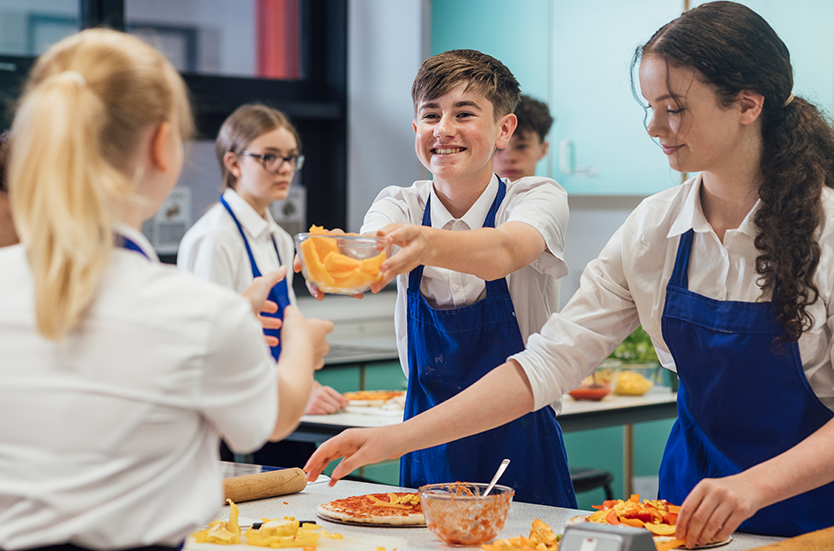Help students develop food skills and learn about personal hygiene and kitchen safety.
Important life skills
Are you looking for a fun way to teach students important life skills? Get students cooking to build lifelong food skills. They will also practise reading and math, without it feeling like schoolwork.
This kind of hands-on learning matters, since many students don’t learn food skills at home. Highly processed and convenience foods have become the easy choice in our busy world. Teaching food skills helps students build confidence and experience success. They may be more open to trying new foods they’ve helped prepare.
Refer to the free downloadable kit Classroom cooking from TeachNutrition.ca. This can help you guide students through cooking activities in any classroom. No kitchen needed!
Equipment checklist
A fully equipped kitchen isn’t necessary to do cooking activities. You can gather basic equipment for no-bake cooking in the classroom. For example, multiple measuring cups, spoons, bowls, butter knives or cutting boards. See the full equipment checklist in the classroom cooking kit.
Once you have gathered the items, help students become familiar with them. Use the Kitchen tools worksheet from the classroom cooking kit. Students can practise identifying each tool by matching its name to the picture.
Teaching proper techniques
Building kitchen skills helps boost student confidence! Use the Cooking technique illustrations from TeachNutrition.ca. This resource helps students practise skills like measuring, pouring and mixing. It highlights age-appropriate tasks and shows how skills can progress. For example, start with a butter knife to cut soft foods before using a paring knife. Encourage students to bring their sheets home to practise.
- Review each skill with students before starting the cooking activity. Gather students at one table to show proper techniques.
- Have students apply what they have learned. Use the Measure it right student worksheet included in the kit from TeachNutrition.ca.
Choosing recipes to practise different skills
- Ask students if they want to try certain recipes.
- Consider food intolerances, allergies and restrictions based on personal choices, religion and culture.
- Serve small samples to students. One serving from a recipe should provide 3-4 samples for students.
- Check out the four no-bake recipes included in the classroom cooking kit. Each recipe focuses on two specific skills for students to practise. For example, the No blender smoothie uses just three ingredients and is mixed in a cup. This makes this recipe simple and accessible. The Checkerboard cheese sandwich lets students use a butter knife to cut cheese. This allows them to practise both food prep and math skills like fractions.
Stretch your food budget
Use these simple tips to make your food budget go further for classroom cooking activities.
- Check grocery store flyers for sales.
- Choose generic store brands over popular name brands.
- Use marked-down items close to expiring and use them right away.
- Use “imperfect” vegetables or fruit. Chop them up and use them in a recipe.
Set clear expectations
- Discuss the importance of personal hygiene and food safety in cooking. Read the article Food safety tips for classroom cooking. The Germ spreader activity can show why clean hands and good hygiene matter.
- Brainstorm a list of clean-up duties with students. Tasks will vary if you're cooking in a regular classroom or a foods/tech lab. For example, it could be discarding paper plates, napkins and leftover food. It could be wiping desks or counters or doing the dishes.
Enjoying food with others
Teach students that food goes beyond energy and nutrients. It’s something to enjoy, explore and share with others!
Cooking and eating together helps students build community. It allows them to take pride in their work and reflect on what they learn. Encourage reflection and conversation with open-ended questions like:
- “Would you make this recipe again?”
- “What would you change or add next time?”
- “What did you like most about making this?”
Eating together supports positive attitudes toward food. Students are more likely to try new foods when they see classmates enjoying them. When it’s time to taste the food, keep the experience pressure-free. Invite students to taste, without any pressure to like or finish the food.

